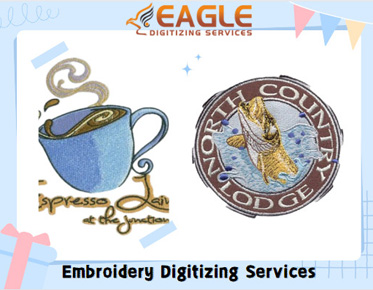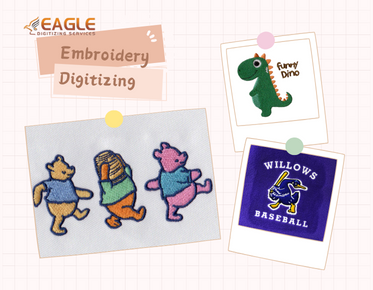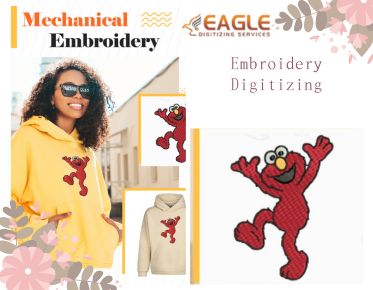Get It Right: Preparing Artwork for Embroidery Digitizing
Embroidery digitizing is the magical transformation of your artwork into a digital format that machines can stitch. It’s not just a technicality; it’s an essential process that ensures your designs come to life on fabric with precision and flair. A well-digitized design retains the intricacies of your original artwork while adapting it for embroidery techniques, ultimately defining the quality of the finished product.
The Importance of Proper Artwork Preparation
Before sending your artwork off for digitizing, preparation is key. Properly prepared artwork minimizes errors and maximizes the integrity of your design. It allows digitizers to focus on what matters: translating your vision into a stunning embroidered piece. Without this step, the risk of miscommunication and disappointing results skyrockets.
Choosing the Right File Format
Common File Formats: PNG, JPG, and AI Explained
When preparing your artwork, file format matters immensely. Common formats like PNG and JPG are often used, but they come with limitations—especially in terms of scalability and clarity. PNG files offer transparency, which is great for overlays, while JPGs can lose quality when resized. Adobe Illustrator (AI) files, however, are vector-based and can be scaled infinitely without losing clarity, making them a preferred choice for embroidery.
Why Vector Files Are Preferred for Embroidery
Vector files are the holy grail of embroidery digitization. They use mathematical equations to create images, ensuring your designs remain crisp and clear at any size. Unlike raster images, which can pixelate, vectors preserve every nuance of your artwork, making them ideal for complex designs. This clarity translates directly into the quality of your embroidery.
Ensuring High Resolution for Clarity
Understanding DPI: What You Need for Quality Designs
Resolution is crucial for achieving high-quality embroidery. DPI, or dots per inch, is a key metric; higher DPI means better clarity. For embroidery, a resolution of at least 300 DPI is recommended. This ensures that your design retains its details and vibrancy when stitched.
How to Check and Adjust Image Resolution
Checking and adjusting your image’s resolution is straightforward. Most graphic design software allows you to view and modify DPI settings. If your image falls short, you can often increase the resolution; however, doing so with raster images may introduce blurriness. For vectors, simply adjusting the dimensions can achieve the desired quality.
Simplifying Complex Designs
Why Less is More: The Benefits of Simplicity
In the world of embroidery, simplicity reigns supreme. Overly intricate designs can become muddled when stitched, losing their intended impact. A simpler design often leads to cleaner lines and a more professional finish, allowing your brand message to shine through without distraction.
Strategies for Breaking Down Detailed Artwork
Breaking down complex designs can be an art form in itself. Focus on the core elements of your artwork, stripping away non-essential details. Consider using a grid system to help visualize how to simplify without losing the essence of the design. This method ensures that what remains is impactful and stitch-ready.
Color Considerations for Embroidery
Selecting the Right Colors: Thread Matching Basics
Color selection is pivotal in embroidery. Threads may not perfectly match digital colors, so understanding the basics of thread matching is essential. Consider using a physical thread color guide to select shades that align closely with your vision. This step will help avoid any surprises during the stitching process.
Understanding the Color Limitations of Embroidery
Embroidery has its limitations, especially when it comes to color choices. Some hues might not translate well on fabric, appearing differently than intended. Familiarizing yourself with these limitations ahead of time can prevent disappointments and ensure your final product looks cohesive and professional.
Creating a Color Palette
How to Choose a Cohesive Color Scheme
A well-thought-out color palette is crucial for any embroidery project. Aim for a cohesive scheme that reflects your brand's identity. Use a color wheel to identify complementary colors and harmonize your choices. This thoughtful selection can elevate your design, making it visually appealing and memorable.
Using Color Swatches for Accurate Representation
Color swatches are invaluable for visual representation. They provide a tangible reference for how colors will appear in embroidery. Always create swatches of your chosen palette to share with your digitizer. This ensures everyone is on the same page and helps avoid any color discrepancies.
Choosing the Right Stitch Types
Overview of Common Stitch Types: Satin, Fill, and Running
Understanding stitch types is fundamental in embroidery. Satin stitches are ideal for smooth, flowing designs, while fill stitches provide depth for larger areas. Running stitches offer a delicate touch, perfect for outlines or fine details. Each type plays a role in the overall aesthetic of your piece.
Matching Stitch Types to Your Design Elements
Choosing the right stitch type depends on your design elements. If your logo features intricate curves, satin stitches are the way to go. For broader areas, opt for fill stitches to maintain texture. Evaluating your design holistically will guide you toward the most suitable stitch types.
Setting the Right Size for Your Artwork
Importance of Scale: How Size Affects Detail
Scale significantly impacts how details are perceived in embroidery. An oversized design can lose its finesse, while a tiny logo may not convey your brand’s message effectively. Finding the sweet spot where size complements detail is crucial for a successful final product.
Tips for Resizing Without Losing Quality
Resizing artwork should be approached with care. When working with vector files, scaling up or down is effortless without quality loss. For raster images, maintain proportions while resizing, and always check the resolution to ensure clarity remains intact. Test prints can help gauge how the design will appear in different sizes.
Understanding Stitch Density
What is Stitch Density and Why It Matters
Stitch density refers to how closely the stitches are packed together. It plays a vital role in the appearance and durability of the embroidery. A higher density results in a more pronounced design but can lead to stiffness, while a lower density allows for flexibility but may dilute detail.
How to Adjust Density for Different Fabrics
Adjusting stitch density according to fabric type is essential. Heavier fabrics can handle more density, providing durability. Lighter fabrics, however, benefit from a more moderate density to maintain softness. Always test the density on a sample fabric to ensure optimal results.
Preparing Text Elements in Your Artwork
Converting Text to Outlines: Why It’s Essential
Converting text to outlines is a critical step in preparing artwork for embroidery. This process transforms font characters into vector shapes, ensuring consistency regardless of whether the font is installed on the digitizer's system. It eliminates the risk of misalignment or font substitution, preserving the integrity of your design.
Choosing Fonts That Are Embroidery-Friendly
Selecting an embroidery-friendly font can make a world of difference. Look for bold, simple fonts that maintain readability even at smaller sizes. Avoid overly intricate or script fonts, which may become illegible when stitched. This consideration enhances clarity and professionalism in your final product.
Adding Borders and Outlines
How Borders Enhance Design Visibility
Borders can significantly enhance the visibility of your design. They frame your artwork, making it pop against the fabric. A well-executed border can also provide contrast, helping intricate details stand out more effectively.
Tips for Creating Effective Outline Designs
Creating effective outlines requires a delicate touch. Ensure that the outline complements rather than overwhelms your design. A consistent thickness and appropriate color can enhance the overall aesthetic, guiding the viewer’s eye and reinforcing your brand’s identity.
Maintaining Brand Consistency
Ensuring Your Design Reflects Your Brand Identity
Your embroidery should embody your brand’s identity. Every design element—from colors to fonts—should be cohesive and reflective of your brand’s values. This consistency fosters recognition and trust among your audience.
Color and Font Consistency Across Different Pieces
Consistency across various pieces reinforces your brand identity. Ensure that colors and fonts remain uniform across all materials, from business cards to embroidered merchandise. This coherent approach not only enhances professionalism but also strengthens brand loyalty.
Testing and Previewing Your Artwork
The Importance of Proofing Before Digitization
Proofing your artwork before digitization is a critical step. This phase allows for final adjustments and ensures that everything is as intended. A thorough review helps catch any errors that could lead to costly mistakes during the embroidery process.
How to Create Mockups for Visual Reference
Creating mockups offers a valuable visual reference for your design. Use graphic design software to overlay your artwork onto a representation of the final product. This visual aid can help identify any potential issues and provide a clearer vision of the finished piece.
Understanding Fabric Choice
How Different Fabrics Affect Your Design
Fabric choice can dramatically impact how your design translates. Each fabric has unique characteristics—some are sturdy and hold stitches well, while others are delicate and may require special considerations. Understanding these nuances will help you adapt your artwork accordingly.
Adapting Artwork for Various Fabric Types
When adapting artwork for different fabrics, consider their texture and weight. Heavier fabrics may require adjustments in stitch density, while lighter fabrics might benefit from simplified designs. Testing on the chosen fabric is essential to ensure the best results.
Common Mistakes to Avoid
Overcomplicating Designs: A Pitfall to Watch For
One of the most common mistakes is overcomplicating designs. Strive for simplicity; intricate details often get lost in the stitching process. Remember, clarity and impact go hand in hand in embroidery.
Ignoring Fabric Limitations: Choosing Wisely
Ignoring the limitations of your chosen fabric can lead to disappointing results. Always consider how fabric characteristics will affect your design, and adapt accordingly. This foresight will ensure your final product meets expectations.
Evaluating Your Final Artwork
Key Features to Review Before Sending Off
Before sending off your artwork, review key features meticulously. Check for clarity, color accuracy, and overall visual appeal. Ensure that the design aligns with your original vision and is ready for the digitization process.
Ensuring Readability and Visual Appeal
Readability and visual appeal are paramount in embroidery. Ensure that text elements are legible and that design elements flow harmoniously. A well-crafted piece not only looks good but also effectively communicates your brand message.
Final Steps Before Sending to Digitization
Checklist for Artwork Preparation
Before hitting send, follow a checklist to ensure everything is in order. Verify file formats, resolution, color choices, and any necessary outlines or borders. This thorough review can save time and prevent costly revisions later.
Ensuring Everything is in Order
Double-checking details ensures that your artwork is ready for digitization. A well-prepared piece not only improves the digitization process but also increases the likelihood of a stunning final product.
Preparing artwork for embroidery digitizing in USA is a journey filled with creativity and precision. By following these guidelines, you can ensure that your designs come to life with clarity and vibrancy. Embrace the opportunity to experiment and create confidently, knowing that a well-prepared design is the first step toward embroidery success.



